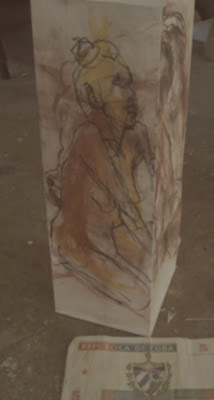I've always thought that in matters of sexual proclivity, over-interpretation leads toward the unfortunate path of confusion and misdirection. Priapic Picasso is not, I believe, a serious point of intellectual departure. Buggering Francis Bacon is an equally one-dimensional caricature that is both hopelessly parochial and depressingly puerile. My uncle Micah Carpentier was similarly reduced by his copulatory curriculum vitae into a gay rights warrior at the expense of his importance as a highly original 20th century Latin American modernist.
 |
| Calamus no. 12, Micah Carpentier, 1965 |
True, his 1965 series Calamus which boldly depicted "the manly love of comrades," shattered many taboos and breached a myriad of forbidden boundaries. And yet, I insist that these works stand strongly on their own regardless of their loaded and explicit subject matter.
What the tenure trackers fail to grasp is that in the first decade of post-revolutionary Cuba overt expressions of homosexuality was neither a cause for concealment nor a pretext for approbation. It's true that Che Guevara's bisexuality was not at the time an open secret as some scholars claim, but that's only because secrecy was deemed wholly unnecessary.
And not only did my uncle's work deal explicitly with homoeroticism, he was equally at home in the lusty, sweaty straight world as well.
In The Song Of Degrees, Carpentier's five-hundred paper bag magnum opus, he drew countless images of the dancer BeBe Tumbao who appears to be in an incessant state of peakless climax. And yet, despite this, no scholar to date has linked these works with anything remotely related to the narrative of sexuality. Rather, it is uniformly understood that Carpentier's compulsive series of scribbled bags deal directly with the rituals of Santería as seen through a post-war neo-Kantian lens. (See Micah Carpentier, Transcendental Idealism and the Cuban Revolution by Minu Induad, Periódica de la Razón Contemporánea, Vol XXII No 3)
I am rather exhausted rehearsing what by now should be nakedly obvious. Yet with each new batch of recently minted PhD's I find myself, once again, defending by uncle's work against innocent yet persistent misunderstanding.
As the Cult of Carpentier continues to expand I suppose I must concede that meaning is inherently unstable and that insignificant speculation is sewn into the fabric of fame.
At least no one claims that Carpentier was a Zionist.
What the tenure trackers fail to grasp is that in the first decade of post-revolutionary Cuba overt expressions of homosexuality was neither a cause for concealment nor a pretext for approbation. It's true that Che Guevara's bisexuality was not at the time an open secret as some scholars claim, but that's only because secrecy was deemed wholly unnecessary.
And not only did my uncle's work deal explicitly with homoeroticism, he was equally at home in the lusty, sweaty straight world as well.
In The Song Of Degrees, Carpentier's five-hundred paper bag magnum opus, he drew countless images of the dancer BeBe Tumbao who appears to be in an incessant state of peakless climax. And yet, despite this, no scholar to date has linked these works with anything remotely related to the narrative of sexuality. Rather, it is uniformly understood that Carpentier's compulsive series of scribbled bags deal directly with the rituals of Santería as seen through a post-war neo-Kantian lens. (See Micah Carpentier, Transcendental Idealism and the Cuban Revolution by Minu Induad, Periódica de la Razón Contemporánea, Vol XXII No 3)
I am rather exhausted rehearsing what by now should be nakedly obvious. Yet with each new batch of recently minted PhD's I find myself, once again, defending by uncle's work against innocent yet persistent misunderstanding.
As the Cult of Carpentier continues to expand I suppose I must concede that meaning is inherently unstable and that insignificant speculation is sewn into the fabric of fame.
At least no one claims that Carpentier was a Zionist.


